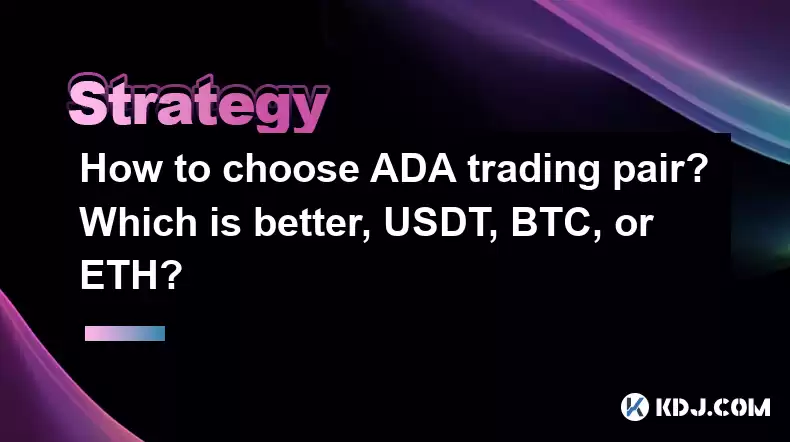-
 bitcoin
bitcoin $108842.957301 USD
-1.88% -
 ethereum
ethereum $3931.777121 USD
-1.66% -
 tether
tether $1.000186 USD
-0.03% -
 bnb
bnb $1153.250882 USD
-2.20% -
 xrp
xrp $2.367904 USD
-1.94% -
 solana
solana $186.182050 USD
-4.20% -
 usd-coin
usd-coin $0.999997 USD
0.00% -
 tron
tron $0.316949 USD
-1.00% -
 dogecoin
dogecoin $0.190780 USD
-3.12% -
 cardano
cardano $0.651324 USD
-2.67% -
 hyperliquid
hyperliquid $37.141055 USD
-0.85% -
 ethena-usde
ethena-usde $0.999224 USD
-0.09% -
 chainlink
chainlink $17.579031 USD
-2.47% -
 bitcoin-cash
bitcoin-cash $509.426284 USD
-2.79% -
 stellar
stellar $0.315298 USD
-2.93%
How to choose ADA trading pair? Which is better, USDT, BTC, or ETH?
Choosing the right ADA trading pair (USDT, BTC, ETH) depends on liquidity, volatility, and your trading goals; each pair offers unique advantages and risks.
Apr 28, 2025 at 11:36 pm

Choosing the right trading pair for Cardano (ADA) can significantly impact your trading strategy and potential returns. When deciding between trading ADA against USDT, BTC, or ETH, it's crucial to consider several factors such as liquidity, volatility, and your trading goals. In this article, we will delve into these aspects to help you make an informed decision.
Understanding Trading Pairs
A trading pair is a combination of two assets that can be traded against each other on an exchange. For instance, ADA/USDT, ADA/BTC, and ADA/ETH are trading pairs where ADA is traded against USDT, BTC, and ETH, respectively. Each pair has its unique characteristics that can influence your trading experience.
Liquidity and Trading Volume
Liquidity is a critical factor to consider when choosing a trading pair. High liquidity means that there are enough buyers and sellers in the market, which leads to tighter spreads and less slippage. Trading volume is a direct indicator of liquidity.
ADA/USDT: This pair typically has high liquidity due to the widespread use of USDT as a stablecoin. It's often the most liquid pair for ADA, making it easier to enter and exit trades with minimal slippage.
ADA/BTC: This pair can also have high liquidity, especially on exchanges where Bitcoin is the dominant trading asset. However, the liquidity might be lower compared to ADA/USDT, depending on the exchange.
ADA/ETH: Generally, ADA/ETH might have lower liquidity compared to the other two pairs. This can result in higher slippage and wider spreads, which can affect your trading costs.
Volatility and Market Correlation
Volatility refers to the degree of variation in trading prices over time. Higher volatility can offer more trading opportunities but also comes with increased risk.
ADA/USDT: Since USDT is a stablecoin pegged to the US dollar, the volatility in this pair primarily comes from ADA's price movements. This can be advantageous if you want to focus solely on ADA's performance without the added volatility from another cryptocurrency.
ADA/BTC: This pair's volatility is influenced by both ADA and BTC's price movements. If you believe in a specific correlation between ADA and BTC, trading this pair might be beneficial. However, it can be more challenging to predict due to the added volatility from BTC.
ADA/ETH: Similar to ADA/BTC, the volatility in this pair comes from both ADA and ETH. If you have a strong view on the correlation between ADA and ETH, this pair could be suitable. However, the added volatility from ETH can make it more complex to manage.
Trading Goals and Strategy
Your trading goals and strategy should guide your choice of trading pair. Are you looking for short-term gains, or are you more interested in long-term holding? Are you comfortable with higher volatility, or do you prefer a more stable trading environment?
ADA/USDT: This pair is often preferred by traders looking for a more stable trading environment. If your strategy involves frequent trading or you're looking to hedge against other cryptocurrency volatility, ADA/USDT might be the best choice.
ADA/BTC: If you believe in a specific correlation between ADA and BTC, or if you're looking to diversify your exposure to cryptocurrencies, this pair could be suitable. It's also a good choice if you're trading on an exchange where BTC is the primary trading asset.
ADA/ETH: This pair might be more suitable if you have a strong view on the correlation between ADA and ETH. It can be beneficial for traders who are comfortable with higher volatility and are looking to capitalize on the movements of both assets.
Exchange Availability and Fees
The availability of trading pairs can vary across different exchanges, and so can the fees associated with trading them. It's essential to consider these factors when choosing a trading pair.
ADA/USDT: This pair is widely available on most major exchanges, and the fees are generally competitive due to the high liquidity.
ADA/BTC: While also widely available, the fees might be slightly higher compared to ADA/USDT, depending on the exchange's fee structure.
ADA/ETH: This pair might be less available on some exchanges, and the fees could be higher due to lower liquidity.
Practical Example: Setting Up a Trade
To illustrate how to set up a trade with each of these pairs, let's walk through the process on a hypothetical exchange.
Setting up an ADA/USDT trade:
- Log into your exchange account.
- Navigate to the trading section and select the ADA/USDT pair.
- Decide on your trading strategy (e.g., market order, limit order).
- Enter the amount of ADA you want to buy or sell.
- Review the order details and confirm the trade.
Setting up an ADA/BTC trade:
- Log into your exchange account.
- Navigate to the trading section and select the ADA/BTC pair.
- Decide on your trading strategy (e.g., market order, limit order).
- Enter the amount of ADA you want to buy or sell.
- Review the order details and confirm the trade.
Setting up an ADA/ETH trade:
- Log into your exchange account.
- Navigate to the trading section and select the ADA/ETH pair.
- Decide on your trading strategy (e.g., market order, limit order).
- Enter the amount of ADA you want to buy or sell.
- Review the order details and confirm the trade.
Frequently Asked Questions
Q: Can I switch between trading pairs easily on an exchange?A: Yes, most exchanges allow you to switch between trading pairs easily. You can navigate to the trading section and select the desired pair from the list of available options.
Q: How does the choice of trading pair affect my tax obligations?A: The choice of trading pair can impact your tax obligations, especially if you're trading between cryptocurrencies. For example, trading ADA for BTC might be considered a taxable event in some jurisdictions, whereas trading ADA for USDT might not be if USDT is treated as a stablecoin. It's essential to consult with a tax professional to understand the specific implications for your situation.
Q: Are there any tools or indicators that can help me choose the best trading pair for ADA?A: Yes, there are several tools and indicators that can help you choose the best trading pair for ADA. For instance, you can use liquidity indicators to assess the trading volume and depth of the order book for each pair. Additionally, volatility indicators can help you understand the potential price movements and risks associated with each pair. Some traders also use correlation analysis to identify pairs that move in tandem or inversely, which can inform their trading strategy.
Q: How do I monitor the performance of different ADA trading pairs?A: You can monitor the performance of different ADA trading pairs using various tools and platforms. Most exchanges offer real-time charts and data for each trading pair, allowing you to track price movements, trading volume, and other key metrics. Additionally, there are third-party platforms and apps that provide comprehensive analysis and monitoring tools for cryptocurrency trading pairs.
Disclaimer:info@kdj.com
The information provided is not trading advice. kdj.com does not assume any responsibility for any investments made based on the information provided in this article. Cryptocurrencies are highly volatile and it is highly recommended that you invest with caution after thorough research!
If you believe that the content used on this website infringes your copyright, please contact us immediately (info@kdj.com) and we will delete it promptly.
- BlockchainFX: The Altcoin Primed to Dominate the Next Bull Run?
- 2025-10-18 00:25:15
- Ethereum, Kevin O'Leary, and Performance: A Shark's Take and the Community's Rebuttal
- 2025-10-18 00:25:15
- ZKP: Zero Knowledge Proof Revolutionizing Gas Fees on the Blockchain
- 2025-10-18 00:30:12
- Whitelists, Zero-Knowledge Proofs, and Blockchain AI: A New Era?
- 2025-10-18 00:30:12
- TAO, Bittensor, and Analyst Optimism: What's Driving the Buzz?
- 2025-10-18 01:05:12
- XLM Token Under Pressure? Decoding Stellar Lumen's Market Dynamics
- 2025-10-18 01:05:12
Related knowledge

Practical parameter settings for a Bitcoin multi-timeframe moving average system
Sep 18,2025 at 10:54pm
Optimizing Timeframe Combinations for Bitcoin Trading1. Selecting appropriate timeframes is crucial when building a multi-timeframe moving average sys...

How can I filter out false breakouts in Dogecoin high-frequency trading?
Sep 22,2025 at 01:00am
Understanding False Breakouts in Dogecoin Trading1. A false breakout occurs when Dogecoin's price appears to move beyond a defined support or resistan...

Techniques for identifying tops and bottoms in the Bitcoin on-chain NVT model
Sep 20,2025 at 07:54pm
Understanding the NVT Model in Bitcoin Analysis1. The Network Value to Transactions (NVT) ratio is often described as the 'P/E ratio' of the cryptocur...

What does the surge in open interest in Bitcoincoin futures mean?
Sep 20,2025 at 11:18pm
Understanding the Surge in Dogecoin Futures Open Interest1. A surge in open interest within Dogecoin futures indicates a growing number of active cont...

How can I use the Ethereum USDT premium to gauge market sentiment?
Sep 18,2025 at 11:55pm
Understanding the Ethereum USDT Premium1. The Ethereum USDT premium refers to the price difference between USDT (Tether) traded on Ethereum-based plat...

What should I do if Ethereum staking yields decline?
Sep 20,2025 at 06:18am
Understanding the Causes Behind Declining Ethereum Staking Yields1. The Ethereum network transitioned to a proof-of-stake consensus mechanism with the...

Practical parameter settings for a Bitcoin multi-timeframe moving average system
Sep 18,2025 at 10:54pm
Optimizing Timeframe Combinations for Bitcoin Trading1. Selecting appropriate timeframes is crucial when building a multi-timeframe moving average sys...

How can I filter out false breakouts in Dogecoin high-frequency trading?
Sep 22,2025 at 01:00am
Understanding False Breakouts in Dogecoin Trading1. A false breakout occurs when Dogecoin's price appears to move beyond a defined support or resistan...

Techniques for identifying tops and bottoms in the Bitcoin on-chain NVT model
Sep 20,2025 at 07:54pm
Understanding the NVT Model in Bitcoin Analysis1. The Network Value to Transactions (NVT) ratio is often described as the 'P/E ratio' of the cryptocur...

What does the surge in open interest in Bitcoincoin futures mean?
Sep 20,2025 at 11:18pm
Understanding the Surge in Dogecoin Futures Open Interest1. A surge in open interest within Dogecoin futures indicates a growing number of active cont...

How can I use the Ethereum USDT premium to gauge market sentiment?
Sep 18,2025 at 11:55pm
Understanding the Ethereum USDT Premium1. The Ethereum USDT premium refers to the price difference between USDT (Tether) traded on Ethereum-based plat...

What should I do if Ethereum staking yields decline?
Sep 20,2025 at 06:18am
Understanding the Causes Behind Declining Ethereum Staking Yields1. The Ethereum network transitioned to a proof-of-stake consensus mechanism with the...
See all articles










































































